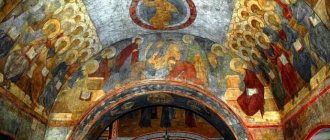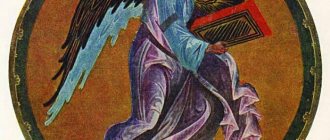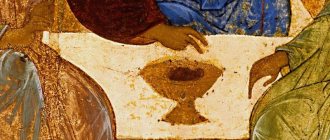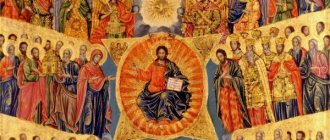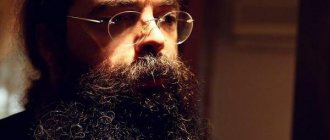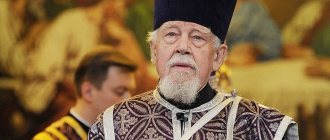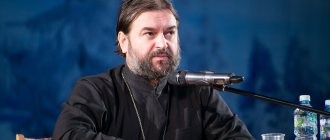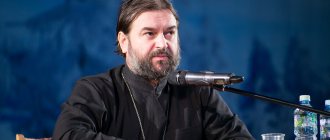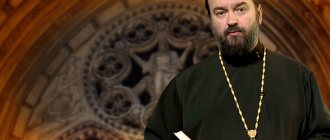Andrei Rublev is a Russian icon painter without a patronymic. This is not surprising, because even the year of birth of this artist is known approximately. Quite a bit of information has been preserved about Andrei Rublev.
He lived quietly, modestly and not particularly noticeably, so that in history, for the most part, his icons have been preserved than his biography. The name of the Russian icon painter was first mentioned in the chronicle in 1405, it says that Andrei Rublev was invited to paint the Annunciation Church in Moscow.
He was not the only one invited; Theophanes the Greek, a famous icon painter and a little-known master, was also called to this good cause. Andrei Rublev was closely connected with Theophanes the Greek in life and work. This happened a very long time ago, during the reign of the Rurikovichs, namely Vasily I, the son of Dmitry Donskoy. These three created the highest iconostasis at that time. Rublev created more than one icon for that temple.
He also painted the Assumption Cathedral in the city of Vladimir. The frescoes he made are still preserved there.
Fresco by Andrei Rublev “The Last Judgment”, 1408 Location: Assumption Cathedral, Vladimir, Russia
Vera Lazarenko, the presenter of a course of lectures on painting, talks about Andrei Rublev like this:
“He's very special. It’s not for nothing that they say that Rublev expressed the highest degree of freedom in his work that was only possible for an icon painter.”
And, indeed, he created icons that were more alive, more humane than many before him.
Who is Andrey Rublev
Historians suggest that the icon painter was born sometime in 1360 or so. There are opinions that he could have been born in 1430. I think this is not so important, because what this man left in the history and culture of his country is much more valuable.
He was born and raised in the Grand Duchy of Moscow. Some biographers suggest that he could have come from Veliky Novgorod. In those days, surnames were given according to occupation or father's name. In the Russian language there is a word “rubel” - a leather tool, which is why the surname Rublev is believed to belong to a craft family.
Wax figure of the icon painter St. Andrei Rublev / Kvesisskaya.tourister.ru
As you know, Rublev became a monk, he was given the name Andrei, his secular name remains unknown. According to some information, which cannot be called reliable, it can be assumed that Rublev’s father’s name was Ivan. Nevertheless, let us dwell on the name that was given to the icon painter when he was tonsured a monk. It can be assumed that the boy began to study art early, since in those days children began to be taught at a fairly early age.
“Rublev” will tell everyone about Orthodoxy. Yuri Grymov opened a new website about faith
Estimated reading time: 3 minutes.
A new Orthodox resource, Rublev.com, has started operating on the Internet. According to its author, the famous director, screenwriter and producer Yuri Grymov , this is the first search engine, navigator and database on Orthodoxy with the ability for visitors to communicate with each other.
Yuri Grymov recalls that after his baptism at the age of 30, he wanted to expand his own knowledge about the Orthodox faith, but he could not always find the information he needed on numerous sites.
Faced with “confusion” in many of them, the director decided to create a universal Internet tool for searching information about Orthodoxy. This should be a clear and convenient guide for both active believers and those who are just looking for the way to the temple.
In addition, Yuri Grymov says that the site is only part of the large Rublev project, which involves the creation in the future of a social network where people will be able to communicate by interests, the Rublev TV channel, as well as a free mobile application, with the help of which, for example, It would be possible to follow the progress of the service online.
Yuri Grymov, director: We must become an example for others
— The voice of the Orthodox media should be very specific. People must clearly understand what this or that information portal is telling them. Specific, verified messages and materials that cannot harm either the reader himself or the one about whom they are writing.
There are cases when, due to the intensity of passions in the media, people fell into depression. Therefore, the Orthodox media must, first of all, be responsible, accurate and competent. This should be a resource that would become an example for many secular people who allow themselves swear words, unverified information, and distorted facts.
To be honest, I myself am not a serious user of social networks. I believe that a thorough dialogue, which takes a lot of time, needs to be done face to face. I had experience communicating with people on the Internet - and I did not like it.
If in front of me is a clone asking unclear questions or an openly rude person, then I believe that the discussion cannot take place. That is why, when we launch our own social network, we will only do direct registration. All other options - bots and incognito - are a thing of the past.
Archpriest Pavel Velikanov, editor-in-chief of the portal “Bogoslov.ru”, consultant of the “Rublev” project: The new site is a person’s guide to the world of the Church
— The resource is aimed primarily at those people who call themselves Orthodox, but in fact are completely non-church. These people feel sympathy and a certain interest in Russian Orthodoxy, they feel that the Russian Church is their home, but for many reasons, including psychological ones, even if they crossed the threshold of the church, they do not feel in it as in their own home. Church space for such people is desirable, but not yet available. In order to help them overcome this difference between desirability and availability, the Rublev portal was created.
For those who themselves are well versed in Orthodoxy, it may be useful - people who are on a spiritual quest can be directed to the site. The main message of “Rublev” is Christian enlightenment and upbringing.
We hope that, as the resource develops, it will become a kind of guide into the world of the Church for those who are looking for answers to key questions of faith. And the point of creating “Rublev” is not to simply give another superficial answer to such requests (which often happens in secular and even Orthodox media), but to ensure that the level of response itself is qualitatively different. We can say that this is a search engine with a pronounced Christian responsibility for the results.
Photo from rublev.com
What is known about the creative path of Andrei Rublev
When he painted the Annunciation Cathedral together with Theophan the Greek and Prokhor the Elder, he was the youngest of them. After three years, Rublev was already painting the cathedral in Vladimir, and by that time he had assistants and students.
Andrei Rublev had his own individual style of icon painting and his own vision of religious subjects. For example, in one of the icons depicting the Nativity of Christ, the Mother of God does not look at the baby, as in most traditional paintings, but in the opposite direction. By this, the icon painter wanted to say that, having brought a savior to the world, the Mother of God turned her gaze to those praying, to people calling on higher powers.
It is believed that Rublev learned a lot from Theophanes the Greek, who owned a special technique. He knew how to draw very quickly, accurately and clearly, but Andrei did not adopt Feofan’s style, but followed his own path in creativity. Many note that even Rublev’s palette was special – sunny and joyful. The faces of his saints turned out to be peaceful and spiritual, with soft facial features.
Andrey Rublev “Nativity of Christ”, 1410s Location: Annunciation Cathedral of the Kremlin, Moscow, Russia
Andrei's assistant in many of his works on painting temples was Daniil Cherny. With him, for example, he painted the Assumption Cathedral near the city of Zvenigorod, the cathedral in Vladimir.
In 1408, the Tatars attacked Rus', many cities were destroyed under the onslaught of the Khan's troops. The Trinity Monastery, where the icon painter also worked, was completely destroyed. All of Andrei Rublev’s paintings disappeared with him. The Assumption Cathedral in Vladimir was also destroyed. When they began to restore the Trinity Monastery, Rublev’s name was again mentioned in the chronicle; this mention dates back to 1422. It was during the painting of this monastery that the most famous icon of the artist-monk “Trinity” was born.
Andrei Rublev “Trinity”, from 1425 to 1427 Location: State Tretyakov Gallery, Moscow, Russia
Andrei joined the church at a young age, he became a monk, so he did not have a family or children. Little is known about the relatives of the icon painter; biographers cannot say whether Rublev had brothers or sisters.
The date of death of the Old Russian artist is also not precisely known, but most likely it dates back to 1428. At that time, the plague was raging, from which the famous icon painter died. The monk was buried in the Andronikov Monastery, where he performed his last work.
Icons and frescoes
- Archangel Michael from the Deesis rank, 1414
- Ascension of the Lord, 1408
- Apostle Paul from the Deesis rank, 1410s. State Tretyakov Gallery (TtG)
- Savior in power, 1408
- Spas, 1410s
- Descent into Hell, 1408-1410. Tretyakov Gallery
- Nativity. Annunciation Cathedral of the Moscow Kremlin
- Archangel Michael, 1408. Cycle of icons of the Deesis tier of the iconostasis of the Assumption Cathedral in Vladimir
- Archangel Gabriel, 1408. Cycle of icons of the Deesis tier of the iconostasis of the Assumption Cathedral in Vladimir
- Our Lady, 1408. Cycle of icons of the Deesis tier of the iconostasis of the Assumption Cathedral in Vladimir
- Gregory the Theologian, 1408. Cycle of icons of the Deesis tier of the iconostasis of the Assumption Cathedral in Vladimir
- John Chrysostom, 1408. Cycle of icons of the Deesis tier of the iconostasis of the Assumption Cathedral in Vladimir
- John the Theologian, 1408. Cycle of icons of the Deesis tier of the iconostasis of the Assumption Cathedral in Vladimir
- John the Baptist, 1408
- Andrew the First-Called, 1408. Cycle of icons of the Deesis tier of the iconostasis of the Assumption Cathedral in Vladimir
- Annunciation, 1405
- Transfiguration, first quarter of the 15th century. Tretyakov Gallery
- Holy Trinity, 1410s. Tretyakov Gallery
Afterword
Rublev’s main iconographic creations are considered to be “Trinity”, “Savior”, “Archangel Michael”, “Apostle Paul”. These paintings can be seen today in the Tretyakov Gallery.
Andrei Rublev is considered an artist of Holy Rus'; at a time when painting was not so developed in the Russian state, icon painting existed and developed. Thanks to this, ordinary people who did not have the opportunity to touch the beautiful could come to the temple and see holy images, frescoes, icons and, at least for a short time, immerse themselves in the world of art.
Andrey Rublev “Archangel Michael with Brands”
Looking at the work of Andrei Rublev, we can say that he became a ray of light in the kingdom of dark and strict icon painting that came before him. Rublev’s icons are imbued with some unimaginable warmth and clarity; he conveys religious subjects in a special way, putting his vision into them. He made a great contribution to the Russian school of icon painting.
The man who was mentioned in the chronicle is clearly special. In Rus', so to speak, they didn’t waste paper, but only recorded significant events in the life of the state. Rublev was canonized in 1988, since then July 17 has been considered a church holiday - the day of memory of Andrei Rublev.
Creation
The formation of Rublev's worldview was greatly influenced by the atmosphere of cultural upsurge of the 2nd half of the 14th - early 15th centuries, which was characterized by a deep interest in moral and spiritual problems. In his works within the framework of medieval iconography, Rublev embodied a new, sublime understanding of the spiritual beauty and moral strength of man. Rublev's creativity is one of the pinnacles of Russian and world culture.
In 1408, Rublev, together with Daniil Cherny and other masters, created his only accurately dated and, in addition, preserved work - the frescoes of the Assumption Cathedral in Vladimir (the painting was partially preserved). Of Rublev’s frescoes in the Assumption Cathedral, the most significant is the composition “The Last Judgment,” where a traditionally formidable scene turned into a bright celebration of the triumph of justice, affirming the spiritual value of man. Rublev's works in Vladimir indicate that already at that time he was a mature master who stood at the head of the school of painting he created.
In 1425-1427, Rublev, as the chronicles testify, together with Daniil Cherny and other masters, painted the Trinity Cathedral of the Trinity-Sergius Monastery and created the icons of its iconostasis. Icons have been preserved, which are considered for the most part to be the work of the artel; they are made in different manners and are of unequal artistic quality. Probably, it was this iconostasis that included the icon of the “Holy Trinity” - his only unconditional surviving work in the genre of icon painting. Rublev filled the traditional biblical story with deep theological content.
Most researchers agree that he most likely painted “Our Lady of Vladimir” (circa 1409, Assumption Cathedral, Vladimir) and part of the miniatures of the “Khitrovo Gospel” (circa 1395, Russian State Library, Moscow).
Other icons and frescoes, attributed throughout the 20th century to the brush of Andrei Rublev, are now considered by most researchers to be the work of a school (artel) or even simply of the master’s contemporaries.
Andrei Rublev's teacher was Feofan the Greek
Chronicles say that Andrei Rublev worked with such masters as Prokhor the Elder and Daniil Cherny, who was his partner on his travels. However, Andrei Rublev’s teacher is Feofan the Greek.
It was from him that the icon painter acquired the skills of Byzantine writing and with his help became acquainted with Byzantine visual culture.
Feofan the Greek and Semyon Cherny painting the Church of the Nativity (miniature of the Front Chronicle, 16th century). Theophanes the Greek arrived in Rus' from Byzantium
The greatest Byzantine and Old Russian icon painter, master of fresco paintings and miniatures, Theophanes the Greek was born in 1340 and died in 1410. He was born in Byzantium. That is why he received the nickname “Greek” in Rus'.
Before the invitation to Rus', he lived and worked in Constantinople and other Byzantine cities. Immediately before his arrival, he lived for a long time in the Cafe. This is now Crimean Feodosia. Historians claim that he came to Rus' together with Metropolitan Cyprian.
Initially he settled in Novgorod. This happened in 1370. Here he painted the Church of the Transfiguration on Ilyin Street. Feofan had a huge influence on the development of all art of Veliky Novgorod. This applies to both fresco painting and icon painting.
Further information about the activities of Theophanes the Greek is vague. According to some reports, he continued his work in Nizhny Novgorod, and also visited Kolomna and Serpukhov. At the beginning of 1390 he arrived in Moscow. Here he painted temples, private houses, painted icons and miniatures for books.
Video: Icon painting school: Theophanes the Greek, Rublev, Dionysius. At 3.20 minutes, the author says that Andrei Rublev, unlike Theophan the Greek and other icon painters, paints an icon as a prayer, as a contemplation of the beauty of God.
Andrei Rublev, together with Theophan the Greek, worked in 1405 on the painting of the Annunciation Cathedral in the Moscow Kremlin.
1405
this year Rublev is working on the painting of the Annunciation Cathedral of the Moscow Kremlin
This period of his life dates back to his acquaintance with the Byzantine icon painter and training with him.
Art historians point out that Feofan introduced Andrei to the Byzantine tradition in the fine arts. Working with him, the monk honed his writing technique.
This seriously affected the formation of Rublev’s style, which began to approach canonical Byzantine writing.
Subsequently, the monk worked independently or in collaboration with Russian masters. He developed his own artistic style, which absorbed the best examples of Byzantine art, but did not copy it.
He is characterized by calmness and tranquility. In addition, all of Rublev’s works are distinguished by an ideal harmony of color, proportion and beauty.
Universal recognition
The works of Andrei Rublev reflect his worldview. That time was characterized by cultural progress and increased attention to moral issues. The artist’s work reflected a new vision of spiritual beauty and morality; it became known and revered not only in his homeland, but also far beyond its borders.
Rublev's works are extremely valuable; very few of them have survived. Numerous studies have identified his works by their unique style. The Trinity icon is the only surviving work that, of course, belongs to the brush of Rublev. Currently kept in the Tretyakov Gallery. There is little controversy about the fact that it belongs to the master, consisting of three icons of the Zvenigorod rank. It reveals a new dramatic trace for Rublev’s work, possibly related to the events of that time (civil strife in Rus').
Most scholars attribute to the authorship of Rublev “Our Lady of Vladimir” and several miniatures of the “Gospel of Khitrovo”. In addition to these works, over the past century, many assumptions have been made in favor of Rublev’s brush. Now all these works are considered works of the school of the famous master. In the middle of the 16th century, his icon painting was recognized as a model to be imitated, and many artists were strongly influenced by Rublev’s work. His works carry deep spiritual content and emotionality combined with laconic and beautiful images.
In 1947, a reserve was opened on the land of the Spaso-Andronikov Monastery, and in 1985, a museum of ancient Russian culture was opened in honor of Andrei Rublev. In 1988, Rublev was canonized as a saint. The artist’s name is on the streets of several Russian cities, monuments are dedicated to him, and films have been made about Rublev. A crater on Mercury was also named after the artist.
Canonization
In 1988 he was canonized as a venerable saint by a local council of the Russian Orthodox Church.
According to the Orthodox calendar, the saint is commemorated three times a year:
- July 4 (17) - repose of St. Andrei (Rublev) of Moscow, icon painter (1428; service without sign).
- July 6 (19) - memory of St. Andrei (Rublev) of Moscow in the Cathedral of Radonezh Saints.
- In the week before August 26 (September 8) - the memory of St. Andrei (Rublev) of Moscow in the Cathedral of Moscow Saints.
Death and memory
The icon painter died in the late autumn of 1428 from the plague epidemic that was raging in Moscow. Death overtook Andrei Rublev in the Andronikov Monastery, where in the spring he, together with Daniil Cherny, worked on his fourth work - the frescoes of the Spassky Cathedral (they have not survived). Soon after the icon painter his faithful colleague and friend left. According to legend, before his death Andrei Rublev appeared to Daniil Cherny, “in joy calling him to heaven.” To Daniel, Andrei’s appearance seemed joyful and bright.
The icon painter was buried near the bell tower of the Spassky Cathedral. In 1988, the artist was canonized and canonized, establishing July 17 as his memorial day. In the mid-1990s, archaeologists discovered the ancient throne of the Spassky Cathedral, and next to it the relics. They were attributed to the famous master, but the statement was soon recognized as erroneous.
Researchers call the generally accepted date of the artist’s death erroneous, claiming that Andrei Rublev died at the end of January 1430. Architect P. D. Baranovsky insists on the date January 29, 1430. The architect assured that it was precisely this that was carved on Rublev’s tombstone before it was lost. The Andrei Rublev Museum of Ancient Russian Art was built on this site, the founder of which was the architect Pyotr Baranovsky.
In the late 1940s, a reserve appeared in the Spaso-Andronikov Monastery. The great Rublev is also remembered in Vladimir: a monument to the icon painter stands at the entrance to the park named after A.S. Pushkin. A crater on Mercury was named in honor of the saint, a series of commemorative coins and a postage stamp were issued. In 1966, the film drama “Andrei Rublev” was shot at the Mosfilm film studio by director Andrei Tarkovsky. The original title of the painting, “The Passion of Andrew,” was abandoned. The film consists of eight short stories, in which the turmoil of the Middle Ages is described through the eyes of the monk Andrei Rublev. The artist was played by actor Anatoly Solonitsyn.
